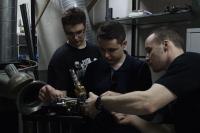Rocket engines built by WUT students – the future of the space industry
Will we soon witness a take-off of a rocket equipped with an innovative engine designed by our students? Incredible as it sounds, this vision may come true thanks to members of the MELprop Propulsion Student Research Group, which operates within the Faculty of Power and Aeronautical Engineering.
Students are working on two types of rocket engines: liquid-propellant and hybrid ones. The former uses an oxidizer (in liquid or gaseous form) and a liquid propellant. It is more efficient, but also more complex (and, consequently, more expensive) than a solid-propellant engine. A hybrid engine uses a liquid oxidizer and a solid propellant. As a result, it is equally efficient as a liquid-propellant engine, but also cheap and simple, just like a solid-propellant engine.
“This can be best explained using the example of a space shuttle, which has both solid-propellant and liquid-propellant engines,” Filip Kopeć says. “The liquid-propellant engines are started first. Their advantage over solid-propellant engines is that combustion can be stopped, e.g. to prevent a disaster when a defect is discovered during the take-off. This is not possible with solid-propellant engines.”
“Hybrid engines, on the other hand, are still largely unused in space missions,” adds Aleksander Gorgeri, the main rocket engine designer in the MELprop Student Research Group. “They were used on SpaceShipOne, the first privately-funded manned spacecraft.”
This means that our students are faced with a great challenge. Especially as hardly anybody in Poland works on this problem. “As far as I know, the only Polish entities dealing with hybrid engines are the Institute of Aviation, the Polish Rocket Society and a group of students from the AGH University of Science and Technology. Research on liquid-propellant engines is conducted by the Institute of Aviation and Jan Kindracki, Ph.D. (Eng.), from the Faculty of Power and Aeronautical Engineering at the Warsaw University of Technology,” Aleksander says.
Large-scale calculations and hard work
The members of the MELprop Student Research Group construct their structures from scratch. They make calculations, select and order parts, test them and, if necessary, change them. “At the beginning, we used nitrous oxide, known as laughing gas, as the oxidizer,” Filip says. “One kilogram costs ca. 40 zloty and we used as much as half a kilogram per second. This is why we switched to carbon dioxide, which is much cheaper and has similar properties, so it is great for testing purposes. But it cannot replace nitrous oxide in a real engine.”
Over a dozen people are involved in the work on the engines. What they need is a mutual help, but also patience, as sometimes it is necessary to wait as long as 1.5 months for new engine components. The reason is that many of them can be manufactured by just one company in Poland.
“It all boils down to writing out several dozen formulas, calculating their differentials, entering them into the MATLAB software and optimizing the code,” Aleksander sums up. “This way we know the engine’s operating parameters and dimensions. They are used to design the entire structure in detail. Then we need to select the right materials and, finally, find a company that will do the construction work.”
Aleksander makes it sound as easy as doing the shopping. But the task is far from simple. It requires knowledge, experience and a computer with adequate processing power. A home PC could need as long as two 2 weeks to complete the task. The one used by our students only needs one day.
It’s working!
Almost one year of work on a hybrid engine paid off at the beginning of August. Our students tested the engine – successfully. “In the future, it will be able to lift a rocket,” Filip has no doubts. “According to our calculations, it can reach a maximum altitude of 12 kilometers,” Aleksander adds.
Other parameters of the engine are also impressive: thrust (the force caused by the ejection of matter) of 1 kilonewton (i.e. 100 kilograms), temperature in the combustion chamber of 3 thousand kelvins (for comparison, the Sun’s surface is almost twice as hot, with a temperature of 5.8 thousand kelvins) and exhaust gas velocity (a key parameter, which shows the efficiency of the unit) of 2 kilometers per second.
.“Our engine is not technologically advanced enough to be used commercially right away, mainly due to budgetary constraints,” Filip points out. “We have enough experience to design such an engine, though.”
Headed for another success
The members of the MELprop Student Research Group are rapidly approaching another important day: tests of their liquid-propellant engine. They have been working on it for two years. Recently, they have tested the fuel system and the cooling system. “It is a typical research project, but it reflects the actual operation of such an engine really well,” Filip says. And Aleksander adds: “In a normal engine, all elements are permanently welded together. The components of our engine can be removed and replaced, making it easy to improve the project.”
Each consecutive stage of work is an opportunity to gain knowledge that is not to be found even in the best textbooks.
The members of the MELprop Student Research Group are grateful to the Dean of the Faculty of Power and Aeronautical Engineering and the company MESco for their help in obtaining a computer workstation with licenses for the ANSYS software.
Agnieszka Kapela
Promotion and Information Office








